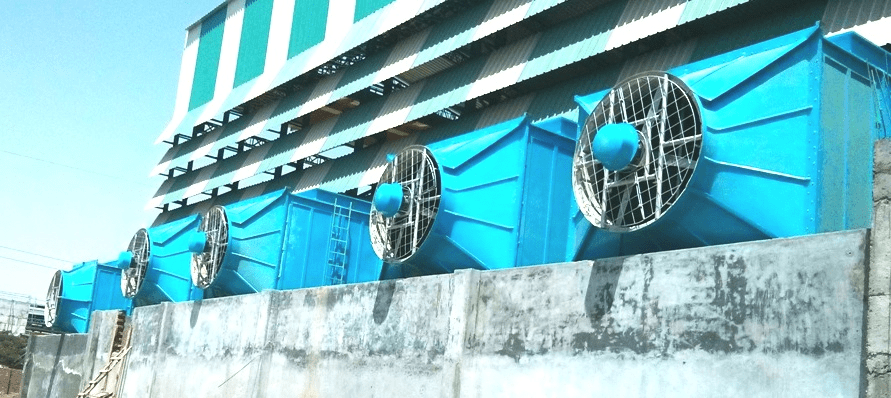Setting up cooling towers comes with its own set of challenges, biofilms are one of those challenges. Biofilms are usually found building in areas that are not accessible to biocide treatments. Once formed, they can rapidly grow to form biofouling deposits which end up causing corrosion damage, blockages, reduced heat transfer and increase the growth of Legionella bacteria. Biofilms can be very cohesive and difficult to remove once they become established.
Cooling towers, be it evaporative cooling towers, natural draft or induced draft cooling towers, are all prone to get infected with the spread of biofilm. To remove heat effectively, it requires the optimal circulation of water in cooling towers which is often vulnerable to microbial overgrowth.
Biofilms are everywhere
A Group of bacteria attached to the surface are called biofilm deposits, they grow inside protective microbial secretions. Biofilms are known to be the most successful form of life on our planet. They are found on both living and inanimate surfaces in possibly every imaginable environment, playing an essential role in the ecology and sustainability of life.
Biofilms are unpreventable in water systems without any intense control measures like those measures that are taken in the pharmaceutical industries. Biofilm control is challenging in evaporative cooling towers; the same goes with cooling towers in general because the systems are inoculated continuously with dust, bacteria, nutrients and even some other contaminants when their ordinary course of operation is on. Practically the only possibility when it comes to the solution is to manage the negative impact of biofilms on heat transfer, flow, corrosion and disease in cooling water systems and not complete elimination.

Biofilms improve survival
Biofilms improve bacterial survival, which is why over 90% of the world’s population of bacteria are found in biofilms. Generally, all water supplies contain free-floating bacteria unless they are sterile. Most of these bacteria are not even detected by standard culture testing. Finding the conditions to be favourable, these bacteria start producing a protective sticky secretion that is called Extracellular polymer substances (EPS) they come in contact with a surface within minutes. Bacteria is likely to start reproducing inside the biofilm in hours. You might start noticing mature biofouling deposits forming complex communities of harmful bacteria and other microorganisms in upcoming days.
Biofilms have a complex structure that protects the growing microorganisms from any environmental dangers which enable worldly communities to develop. These communities can persistently adapt to chemical treatment and even mechanical removal. Biofilms breed by releasing bacteria into the bulk water to settle in other surfaces when the conditions become unfavourable. Possessing multiple survival mechanisms make biofilms extremely difficult to manage and control.
Why are Biofilms tough to control?
Biofilms are prone to begin developing where biocides cannot reach like underneath the dirt in the cooling tower basin or inside dead legs; these are the sections of cooling towers with low or no flow. All types of cooling towers, be it natural draft cooling towers or induced draft cooling towers have ideal conditions for biofilm deposits due to their intricate piping, redundant equipment and constant infusion of nutrients, dirt, debris and bacteria.
The bacterial secretions that collectively form biofilms stick the deposit to the system surface, creating a chemically resistant matrix. It would be difficult for even biocides and cleaners to remove them; hence, they are challenging to remove once established.
Even the extreme doses of biocides, cleaners and dispersants fail to remove established biofilms effectively. If they are not entirely removed, they can rapidly multiply into forming a new, more resistant and impermeable biofilm.
Don’t Miss: Evaporative Cooling Towers: Brief Guide
Importance of cleaning and disinfecting Cooling towers
In order to minimise the risk of biofilms, proper management and cleaning measures should be considered. disinfecting cooling towers periodically may minimise the effect of biofilm and stop it from spreading. At towertech India, we implement a comprehensive inspection and carry out required measures for cooling tower repairs.

Fairly managing biofilm requires a thorough approach.
Managing biofilm effectively in the cooling system is a continuous battle which involves more than just biocide additions. A comprehensive approach is necessary with maintenance protocols, specialized expertise and technologies to address various challenges that are linked with biofilm control and its remediation.
At Towertech India, we assure and elevate the functionality of your cooling towers as needed. We even install new models in case of expensive repairs to retain the performances of foundations and cold water basins. Always ready to assist you in getting the maximum from your evaporative cooling towers and others.


